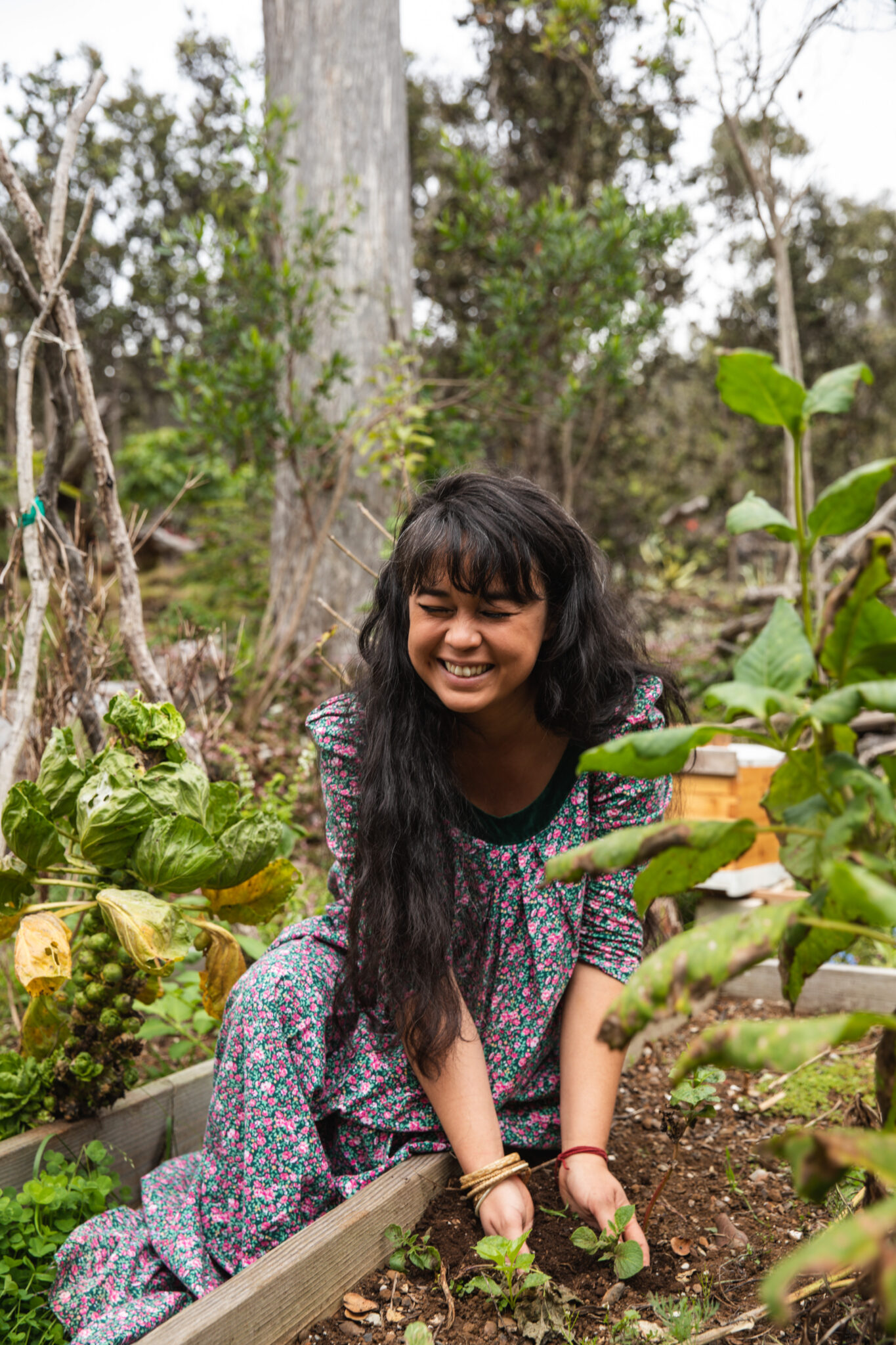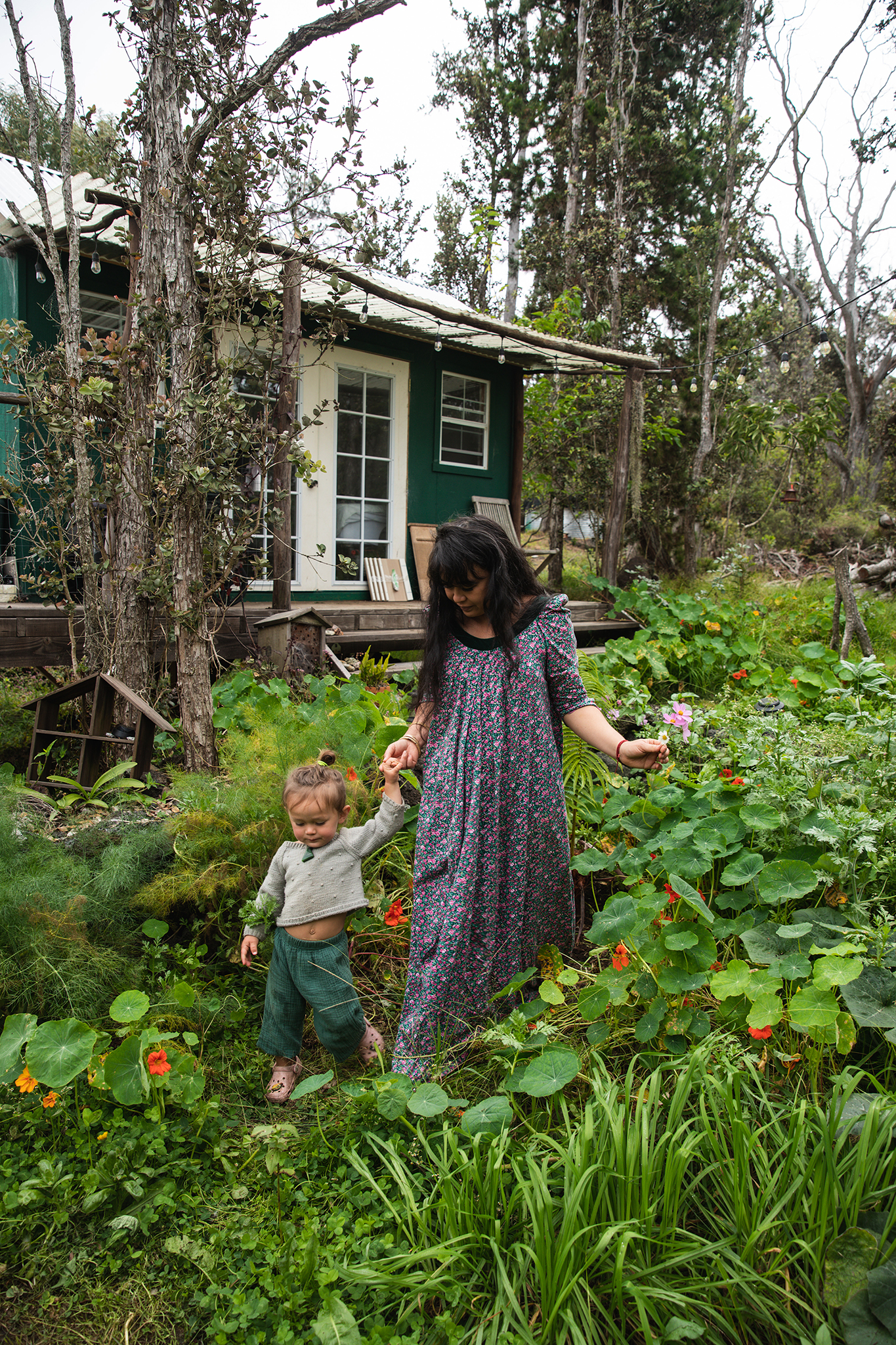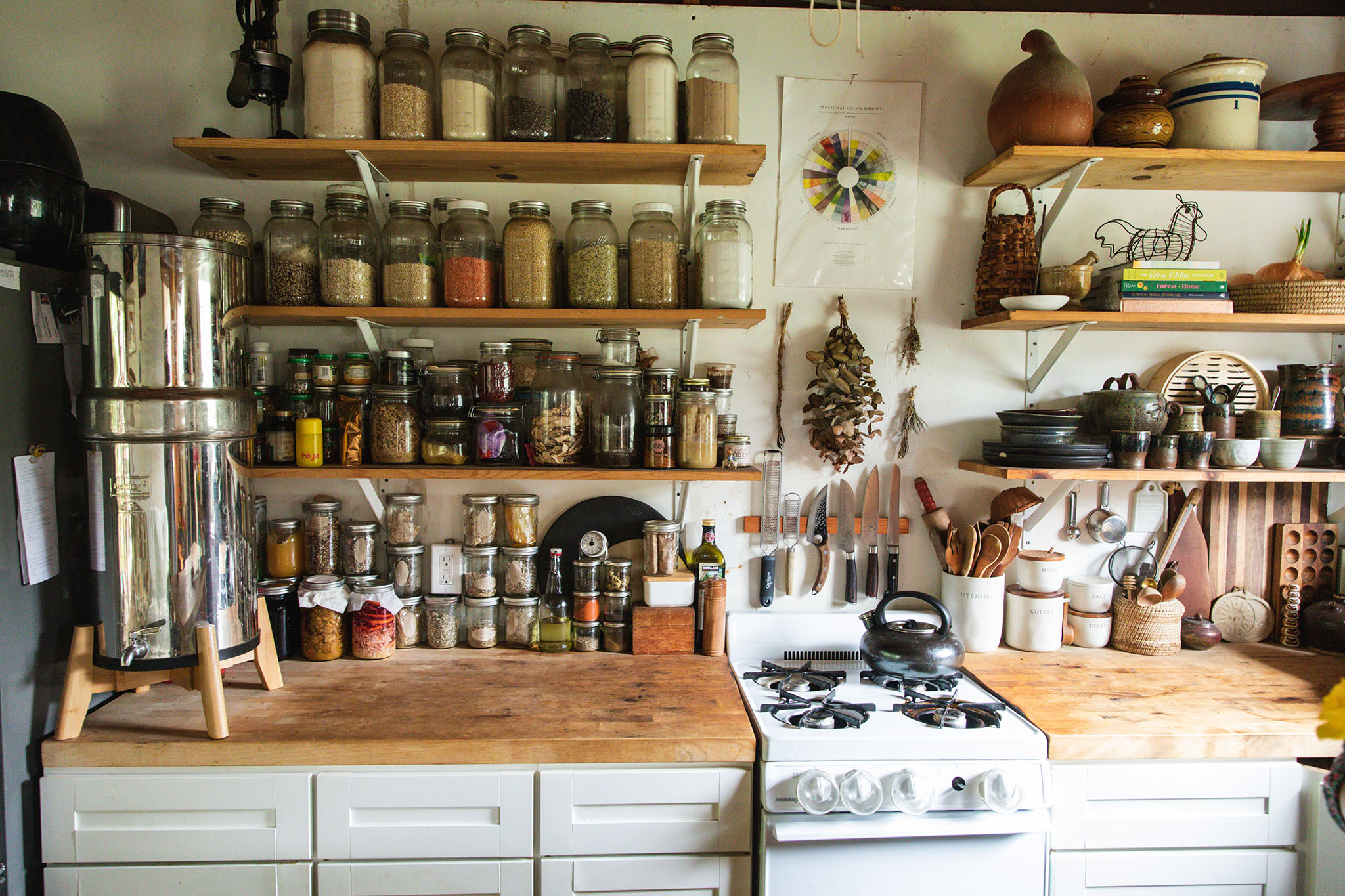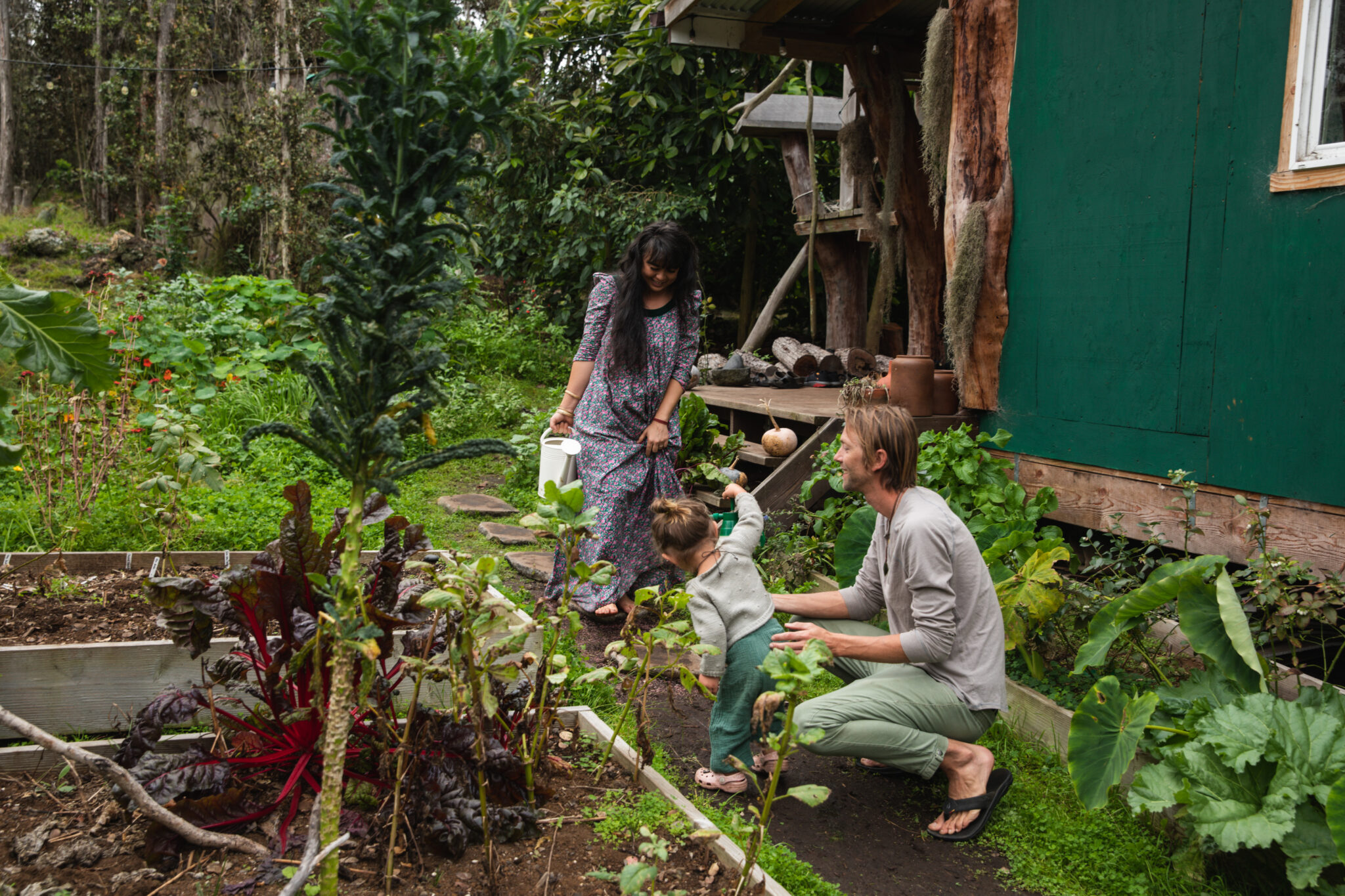At her off-the-grid residence, natural dye artist Waiʻala Ahn cultivates space for people to connect with the natural world and discover their own autonomy.
Images by Nani Welch Keliʻihoʻomalu
Entering through the front gates of Waiʻala Ahn’s homestead in Kaʻū feels like stepping into a fairytale. A small bee box and a row of garden beds overflowing with root vegetables and brassicas are set off to the left; a small cottage sits patiently up the path to the right. The ground is covered in a blanket of clover and wildflowers, and a cadre of stately old-growth ʻōhiʻa trees look down from above. In the distance, Ahn’s two Australian Shepherds greet your arrival.
The verdant space is well suited for Ahn’s work as a natural dye artist. Here, she’s able to grow many of her art materials and host dye workshops on her covered lānai. But to Ahn, who is Native Hawaiian, her homestead is far more than an avenue for her work — it represents her steadfast commitment to her values and radical optimism for the future of Hawaiʻi.
Ahn, her husband and indigo artist Justin Cook Tripp, and their two-year-old son Kupuʻohi live more than two hours away from both Hilo and Kona and 4,500 feet up the slopes of Mauna Loa. Their street runs through a kīpuka of old growth forest, putting them solidly in Lava Flow Zone 2, which encompasses the areas adjacent to and downslope from volcanic rift zones, extending from South Kona to Ocean View and up towards Saddle Road. Their one-bedroom house is fully off-grid and requires a constant awareness of the limitations of their solar panels and water catchment systems. Despite its inconveniences, this lifestyle was very carefully cultivated.
Before moving to Kaʻū at the end of 2018, Ahn and Tripp were living in Waikoloa, in a house that could be anywhere in Hawaiʻi, or in other words, newly constructed lots surrounded by gravel and concrete, with air conditioners and big screen televisions with every room occupied by residents working multiple jobs just to get by. “Maybe it’s because I grew up in Puna, in a very off-grid community, but it got to the point where I was like, I’d rather live in a tent in the bushes than a place where I was completely disconnected from the world,” says Ahn.


The whole idea of off-grid living was a return to sovereignty in a way that was tangible to us as a family, until it’s tangible to us as a nation.
Wai‘ala Ahn
“I wanted us to have time to not have to work five days a week, two jobs a day.” And so, when Ahn found a small parcel in Ocean View with two solar panels, a water tank, and an enclosed structure that had two working light bulbs at an affordable price, she thought it was just perfect.
The transition to the homestead was not without its challenges. At one point, rain started coming through the walls of the house, but to Ahn, it was all an exercise in reprioritizing and redefining what was most important for her family. Although they were farther from the conveniences of a larger town, they were also free from the financial burdens of rent and utilities. And that was the whole point. “Here in Hawaiʻi, our lives have been defined by these very constructed ideas of what housing and land use is, but we can all take a few small, necessary steps to get back to a way that works for us,” Ahn says. While off-grid living is a pretty drastic step, she acknowledges, things like growing your own food, reducing your electricity and water bills, and mending your old clothes are fairly attainable ways for anyone to build autonomy and reduce dependency on capitalism and corporations. “To me, the whole idea of off-grid living was a return to sovereignty in a way that was tangible to us as a family,” she says, “until it’s tangible to us as a nation.”
Ahn’s commitment to Hawaiian sovereignty is also reflected in the way she runs her business. Instead of selling her art, she holds workshops and offers dye services to other artists. In doing so, Ahn focuses on building community, perpetuating knowledge, and helping others see what is possible beyond the template provided to us by modern society.


“I’m trying to cultivate an opportunity for all people to be connected with the natural world,” she explains. So when they look at the food in their kitchen, for example, they’ll be able to see the color-producing potential and be inspired to make something to gift or sell. And if that goes well, maybe they’ll even decide to grow a small garden and cultivate plants of their own to eat and create with.
Ahn’s workshops are informal, intimate affairs that feel like a gathering of old friends. About 10 participants peruse Ahn’s garden to pick their own flowers to dye with before settling down around a low table on the lānai, reaching across each other for jars of dyeing materials like dried butterfly pea flower and ʻiliahi powder. Throughout an afternoon, Ahn will speak on everything from natural dyeing and the plants being used to homestead life, personal philosophies, and Kupuʻohi’s next birthday party. The evening concludes with a seasonal meal prepared on site by a local chef, and everyone departs with stomachs full and heads buzzing with inspiration. “My hope is that when someone comes in, they can see that on less than a quarter of an acre, they’re able to catch their own water, have solar panels, grow food, and have space for people to gather,” Ahn says, “and that it will help them to reimagine their own communities.”
A Primer to On-Grid Natural Dyeing


“Co-creating with nature can happen anywhere,” says Wai‘ala Ahn. Coffee grounds, tea leaves, avocado seeds, berries, turmeric, and onion skins are all fantastic sources of color, and you can dye anything made from natural fibers (for example, cotton, silk, and linen). Ahn recommends starting with old, stained kitchen towels.
Immersion Dyeing
The simplest method is called immersion dyeing. Using a single dye ingredient, heat it with water on the stove, add your fabric, and simmer for up to two hours, being careful not to let it boil. Then, turn off the heat and let the fabric sit in the liquid overnight.
Bundle Dyeing
Ahn’s favorite method, bundle dyeing, allows for more creativity. Lay your fabric on a flat surface, place your dye ingredients on top, and roll it up tightly. “Like a spring roll, then like a cinnamon roll.” Rubber band it together and steam for 20-30 minutes. o
Pretreating Fabrics
While Ahn pretreats her fabrics to better hold the color, it isn’t necessary, especially if you’re using ingredients with tannins like tea, coffee, and avocado. Just remember not to throw it in your washing machine. “Whatever is going to make a grass stain come out, you don’t want to do with your natural dyed fiber.”

